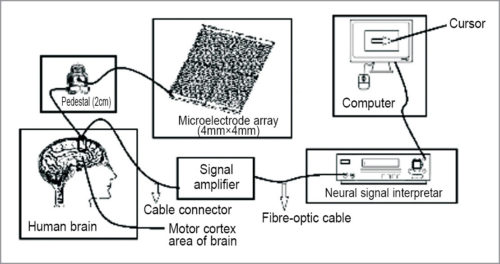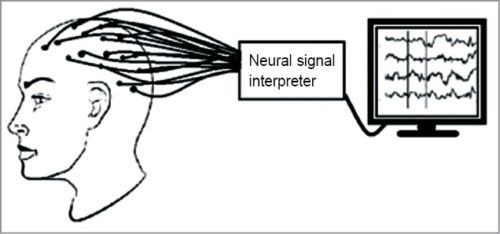Brain gate is a new technological development in the field of medical electronics that enables people with severe paralysis or neurological problems to live more productively and independently.
Brain gate is a brain implanted technology that was first introduced in 2003. It was developed by a bio-tech company called Cyberkinetics, in association with Department of Neuroscience at Brown University, USA. It is a brain-computer interface (BCI) for people who have lost control of their limbs due to any accidental cause, such as spinal cord injury or Amyotrophic Lateral Sclerosis (ALS). It is an interfacing of brain with a computer for productive and independent life of paralysed people, to help them control a computer using their thoughts.
In case of damaged organs or paralysis, the brain is functional, generating signals and sending these to the respective terminals (organs). But, due to paralysis or a damaged organ, control signals are not able to reach their destination(s). A computer chip, known as pedestal, is implanted into the brain. It senses intentions of the user and generates commands accordingly.
In a brain gate system, intentions of the user are converted into electrical signals. These are further decoded using a program that generates control signals to perform tasks like moving a robotic arm or a wheel chair.
The biological neural system
A human brain consists of a complex structure of 100 billion neurons connected to each other through synoptic terminals (Fig. 1). Thoughts processed by the brain are governed by the neurological network of neurons. Dendrites sense neural activities and collectively transfer it to soma, which is a part of the neuron cell body that sums up all dendrites signals. If it is above a particular threshold—which is a minimum signal required to process the action—it is transferred to synopsis through axons (which includes a number of myelin sheath). Synopsis of one neuron is interconnected with dendrites of the other neuron, which, through this signal, is transferred to other neurons, and this process continues.

There are two types of BCI.
One-way BCI
In this mode, information is transferred in only one direction, that is, from brain to computer.
Two-way BCI
In this mode, information exchange occurs in both directions between the brain and the computer.
Basic elements of brain gate
A brain gate implantation system contains a pedestal, connector, neuron signal interpreter and monitor. A pedestal contains a silicon chip, which has 100 hair-thin microelectrodes. Typical dimensions of a pedestal chip are 4mm×4mm×1mm. It is fixed in the motor cortex region of the human brain.
A patient cable connector wire connects a pedestal and an interpreter to convey neuron signals produced by the brain. This signal is further amplified. A neuron signal interpreter converts it into an electrical signal, which can be used to control actions; for example, moving a robotic arm, wheel chair, or the cursor on a computer monitor.
Executing operations using BCI
If a person thinks of doing something, then her or his neural impulse varies according to thoughts. Thus, a neural impulse is generated in the motor cortex of the brain. This movement of generation of a neuron signal is sensed by a microelectrode, which can filter out unwanted signals or noise.
This signal is carried by a connector to a signal amplifier, which amplifies it accordingly and sends to a neural signal interpreter using a fibre-optic cable. The neuron signal interpreter converts this signal or intention of the user into an electrical signal or computer commands.
The computer then works according to the commands and translates these into actions (Fig. 2). The brain gate system can sense many thoughts at a time. It is capable of recording and amplifying numerous intentions of the user in the form of electrical signals.

Methods for sensing neuron signals
Basically, there two methods for sensing neuron signals: electrocorticography (ECoG) and electroencephalography (EEG).
ECoG
This is an invasive method for sensing a neuron signal. In this method, during surgery a chip is placed into the brain. The chip measures the neuron signal flow.
This method requires invasive surgery. However, the most challenging task is that, the chip in the brain, if left for a long time, can damage nearby tissues. This can even cause infections.
It has major advantages, too. Some of these are high spatial resolution, high frequency range, better signal-to-noise ratio and less complexity.
EEG
This non-invasive method (Fig. 3) for sensing a neuron signal does not require surgery. A set of electrodes are attached to the scalp. Since the electrodes are not directly attached to the motor cortex of the brain, some signals are blocked by the skull. This can cause distortion. In this method, temporal resolution is fine, is easy to design, has good portability and low set-up cost. But, it has poor signal resolution due to the dampening of signals by the skull. EEG implantation is carried out by a specialist.

Achievement so far
After its development in 2003, several patients have been implanted with brain gate technology. According to the data proposed by Cyberkinetics and Department of Neuroscience, Brown University, most cases have been of spinal cord injury, while only a few cases were related to advance ALS.
Brain gate project has been approved by Investigational Device Exemption (IDE) of the US. This means that this project is valid for pre-market clinical trials.
Scope and applications
Brain gate technology can sense, record, transmit, analyse and amplify simultaneous movements of a neuron signal. In this technology, a brain gate neural interface system works faster than what is possible with the hands of a person. Using brain gate technology, multitasking is also possible. This means that this device can be used while performing other tasks simultaneously.
Accuracy is not affected by surrounding environment activity. The technology can also be used in a variable environment.
Brain gate allows people to move robotic arms with the help of electrical signals produced by the neural interfaced unit. Using this technology, physically-disabled people can operate a computer through their thoughts and perform computer-based tasks like reading e-mails and moving the cursor.
Brain gate improves the quality of life for physically-disabled people, by allowing them to control TV channels, wheelchairs and so on, through their thoughts. It allows them to work in any industry/organisation.
Challenges
Brain gate technology has the following challenges:
- It is difficult to synchronise the speed of thinking of a person and cursor/robotic arm movement.
- Experiments or trials can be performed with the help of this technology as it is approved by IDE. But, full application on humans is not approved by Food and Drug Administration (FDA), USA.
- Surgery is quite risky and costly.
- Information transfer rate is limited.
- To make the system wireless that will help people be more productive and independent needs work.
Future expectations
Cyberkinetics and Department of Neuroscience, Brown University hope to hone brain gate in upcoming years to make its pedestal more compact, and to make it completely wireless. Brain gate project is hopeful to get approvals from Department of Health and Human Services and FDA in the coming years.
Brain gate has good potential towards brain mapping, storage of memory and advanced humanoid robots.
Dr Rajiv Kumar Singh holds a PhD in electronics engineering from IIT (BHU), Varanasi, and is currently employed with Institute of Engineering & Technology, Lucknow as assistant professor. He has received senior research fellowship of UGC at Centre of Advanced Study at IIT, Varanasi. His interests include wired and wireless technologies for high-speed Internet access.
Vivek Kumar Singh is pursuing BTech in electronics and instrumentation engineering from Institute of Engineering & Technology, Lucknow. His current research interests include biomedical instrumentation.








